Conceived by the PRIMA project, the retinal prosthesis was implanted for the first time at the Fondation Ophtalmologique in Paris.

“The retinal prosthesis was initially designed and manufactured by Daniel Palanker, of Stanford University. The bionic eye works thanks to a microchip consisting of 378 miniaturized ‘photodiodes’, with total dimensions of only 2 millimeters in length and width. Implanted under the retina, it is able to replace the missing retinal ‘photoreceptors’ in patients with age-related macular degeneration (AMD) of atrophic type at the terminal stage of disease, partially restoring lost visual function and, with it, a greater degree of independence and autonomy“. Explains Dr. Andrea Cusumano, researcher in ophthalmology at the University of Tor Vergata and scientific medical consultant of the PRIMA project.
Thanks to the conception of this bionic eye, five blind people, due to a now terminal form of maculopathy have regained, even if only partially still the sight, regaining a minimum of autonomy (they can see very large characters and even sequences of letters).
Maculopathy is the degeneration of the central part of the retina, essential to read, drive, recognize faces and more. The atrophic form (more than 80% of cases) is currently incurable even if new hopes come from clinical studies with a special laser.
The five implants of the bionic eye were carried out at the Fondation Ophtalmologique “Adolphe de Rothschild” in Paris. The implantation of the prostheses was successful and did not alter the patients’ residual vision at all; on the contrary, during the subsequent rehabilitation, there was a gradual increase in visual perception, up to the recognition of forms, letters and numbers.